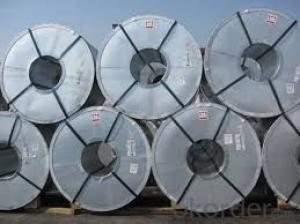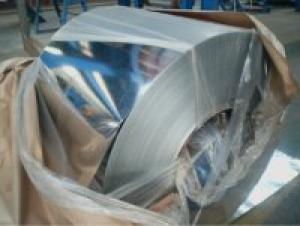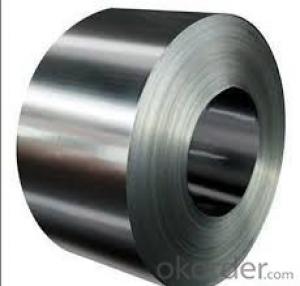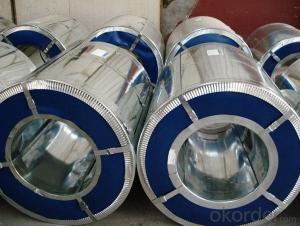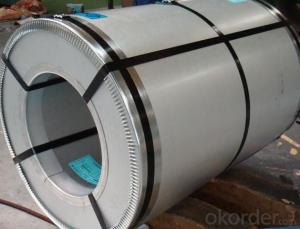hot deep cold rolled 、 galvanized steel coil
- Loading Port:
- Shanghai
- Payment Terms:
- TT OR LC
- Min Order Qty:
- 50 m.t.
- Supply Capability:
- 10000 m.t./month
OKorder Service Pledge
OKorder Financial Service
You Might Also Like
Quick Details
| Standard: | AISI,ASTM,BS,DIN,GB,JIS | Grade: | sgcc, a653 | Thickness: | 0.12-6.0,0.19MM-5.0MM |
| Place of Origin: | China (Mainland) | Brand Name: | CNBM | Type: | Steel Coil |
| Technique: | Hot Rolled,cold rolled | Surface Treatment: | zinc coated,color coated or galvanized | Application: | house construction |
| Special Use: | Wear Resistant Steel | Width: | 700 mm -1250 mm,700 mm-1250 mm | material: | sgcc |
| MOQ: | 25 MT | payment term: | T/T , L/C,O/A | delivery time: | 25-40 days |
Packaging & Delivery
| Packaging Detail: | seaworth packing |
| Delivery Detail: | 25-40 days |
Specifications
Z100 hot deep cold rolled dc51d z galvanized steel coil
1) width:914mm,1200mm,1250mm
2) packing:seaworthy packing
Z100 hot deep cold rolled dc51d z galvanized steel coil
THICKNESS 0.135 MM-4.0 MM
WIDTH 600MM-1500MM ,762 MM,914MM,1000 MM, 1200 MM,1219 MM,1250 MM
ZINC COATING 40G-275G
STANDARD ASTM,AISI,DIN, GB
MATERIAL SGCC,DC51D,DX51D,DX520,SGCD,Q195,Q235,SGHC,DX540,S350 GD,S450 GD,S550 GD
SPANGLE ZERO SPANGLE ,REGULAR SPANGLE OR NORMAL SPANGLE
SURFACE TREATMENT CHROMATED AND OILED, CHROMATED AND NON-OILED
PACKING EXPORT STANDARD
PAYMENT T/T,L/C OR DP
MIN ORDER 25 MT
COIL WEIGHT 3-8 MT
QUALITY SOFT OR HARD QUALITY
CNBM INTERNATIONAL
CNBM International Corporation (CNBM International) is the most important trading platform of
CNBM Group Corporation, a state-owned company under the direct supervision of State-owned Assets
Supervision and Administration Commission of the State Council.
As of the end of 2012, CNBM’s total assets exceeded RMB 300 billion, with more than 150,000
employees, and 20 companies under direct management with 100% share control or majority control,
among which 6 were listed companies, including 2 overseas listed. CNBM ranked NO.319 in the Top
Fortune World 500 of 2013 with 34.46 billion dollars revenue.
For now, we have established strategic partnerships with hundreds of domestic manufacturers and
extensive business relations with clients from over 120 countries in the fields of building materials and
equipments by making full use of its absolute superiority in both abundant source and solid technology
support. Currently, we have wholly-owned overseas subsidiaries and branches in 5 countries with a view
to realize localization, which also represents an essential progress in our globalization target.
STEEL SHEET/COIL DEPARTMENT
Our department is specialized in manufacturing and exporting the following products.
HOT ROLLED STEEL
COLD ROLLED STEEL
HOT-DIP GALVANIZED/ALUZINC STEEL
PRE-PAINTED GALVANIZED/ALUZINC STEEL
PRINTING STEEL
We can ensure that stable quality standards are maintained, strictly meeting both market
requirements and customers’ expectations. Our products enjoy an excellent reputation and have been
exported to Europe, South-America, the Middle-East, Southeast-Asia, Africa and Russia etc.. We sincerely
hope to establish good and long-term business relationship with your esteemed company.
COMPANY
PROFILE
- 1 -
- 2 -
Steel Coil/Sheet
CNBM UAE
CNBM INDIA
CNBM GERMANY
CNBM BRAZIL
CNBM K.S.A
CNBM INDONESIA
CNBM THAILAND
CNBM SOUTH AFRICA
- Q:How are steel coils used in the manufacturing of transmission systems?
- Steel coils are used in the manufacturing of transmission systems to create various components such as gears, shafts, and bearings. The coils are typically shaped, cut, and machined to form these parts, which are then assembled to create the transmission system. The use of steel coils ensures that the components are strong, durable, and capable of withstanding the high loads and stresses experienced in transmission systems.
- Q:can u use stainless steel to make a coin? why or why not? answers based on facts plz.
- Stainless steel has been used by some countries to make coins, but it's not an ideal metal. When a coin is struck, a die comes down and strikes the blank with many tons of force (the blank is also sitting on top of another die--one has the image on the obverse (front) of the coin, while the other die has the image of the reverse of the coin). When the die strikes the blank, the force causes the metal in the blank to flow into the recesses of the die. The problem with stainless steel is that it doesn't want to flow into the die. To get an image, either the relief (how high the raised portion of the design will be) has to be very low, and the coin has to have a simple design, or they have to greatly increase the pressure of the strike. This slows the coining press down, and greatly shortens the life of the dies.
- Q:Why people prefer prefabricated buildings these days? Recently my friend has told me that he is going to owe a steel house so I was just thinking are these steel structures really durable and cheaper than concrete structures?
- It really depends upon the environment and the construction techniques used. Steel that is painted or coated will without maintenance eventually rust. I would expect this tendency to be exacerbated in a humid or shore environment. Heat may tend to cook a steel house and the structure does not add much thermal mass. Construction techniques tend to be fairly quick a part of the construction is essentially prefabricated. Work done in a factory will almost always be cheaper than work done in the field, all things being equal. Concrete can be fairly hi tech with lots of equipment or as seen in many parts of the world fairly low tech with lots of laborers. It is easy to change the characteristics of concrete depending upon how it is mixed, reinforced, and treated during the curing process. Because it is applied in a relatively fluid state it can flow around obstructions like bedrock and be formed up into interesting shapes. A concrete structure can be cooler as it provides thermal mass, and a heat sink. It's resulting rigidity may make it more subject to earthquakes than steel. We do really need to be smarter in constructing our homes to make them fit the land and not only the general environment but our particular micro environment.
- Q:How are steel coils coated to prevent corrosion?
- Steel coils are often coated to prevent corrosion through a process called galvanization. This involves applying a layer of zinc to the surface of the steel coils, which acts as a protective barrier against moisture and other environmental elements. The zinc coating effectively prevents rust and corrosion from forming on the steel surface, extending the lifespan of the coils.
- Q:Like 49ers. Pittsburgh have long history of steel industry?
- Yes. US Steel used to be in Pittsburgh, before Reagan let them move and destroyed Pittsburgh. Pittsburgh also used to have more than 1 million residents (in the early 80s) but now has less than 300K. The Pittsburgh Steelers symbol is the US Steel symbol, colored in.
- Q:What really is the difference between stain-less steel and iron? I only know that iron is an element, and stain-less steel is an alloy...but what else is there?
- Steel is an alloy composed of mainly iron and carbon. Pure iron is very rarely used anymore. Depend on the concentration of the carbon, you can get from wrought iron to high grade steel. For stainless steel, Chromium is added to the alloy to prevent rusting. Just go to wiki. you should be able to find a lot more about it
- Q:What are the different types of steel coil surface protection methods?
- There are several types of steel coil surface protection methods, including oiling, painting, galvanizing, and plastic film coating.
- Q:Suppose that the hardness of steel is uniformly distributed, taking on values between 50 and 80 on the Rockwell B scale.Compute the probability that the hardness of a randomly selected steel specimen is less than 60. a..462b..333c..500d.2e..750 Question 8 Refer to question 7. Compute the probability that the hardness of a randomly selected steel specimen is between 70 and 75.a..167b..500c..063d..100e..
- Suppose that the hardness of steel is uniformly distributed, taking on values between 50 and 80 on the Rockwell B scale. That would be... f(x) = 1/(80 - 50), 50 ≤ x ≤ 80 . . . . . 0 elsewhere Consider this following problem.. Compute the probability that the hardness of a randomly selected steel specimen is less than 60. Here, we have... P(x 60) Oh! Know that the mean and the standard deviation of the uniform distribution function are... ? = (a + b)/2 σ = (a - b)?/12 You should get... ? = 65 σ = 75 Now... P(z (60 - 65)/75) = P(z -0.07) Hence, you should get around 0.462. Good luck!
- Q:I'm ordering a Pair of tongs(a tool used to dig quahogs in bays that scrapes the bottom constantly) and what type of metal would be the best to fabricate it, steel or stainless steel?
- Stainless okorder
- Q:How are steel coils coated for added protection?
- To enhance their durability and resistance to corrosion, steel coils undergo a process known as coil coating, wherein a protective layer is applied onto their surfaces. There are several methods employed to coat steel coils, but the most commonly used one is the continuous coil coating process. Under this process, the steel coil is unwound and extensively cleansed to eliminate any contaminants or impurities on its surface. This step ensures proper adhesion of the coating material. Once the steel coil is cleansed, it undergoes a pre-treatment to enhance its surface properties. Typically, this involves the application of a chemical solution or a conversion coating onto the coil's surface. The aim of this step is to create a surface that is receptive to the coating material and improves its adhesion. Following the pre-treatment, the steel coil is coated with a protective layer, which can be in the form of liquid paint, powder coating, or a combination of both. The coating material is applied evenly onto the coil's surface using techniques like roll coating, spray coating, or electrostatic coating. Once the coating is applied, the steel coil is cured or dried using heat or, in some cases, ultraviolet light. This curing process ensures a strong bond between the coating material and the steel surface, resulting in the desired protective properties. The coated steel coil then undergoes inspection to ensure quality control measures like thickness, adhesion, and appearance are met. If the specifications are satisfied, further processing may take place, involving cutting, slitting, or forming the coil into the desired shape or size. In conclusion, the process of coating steel coils for added protection involves thorough cleansing, pre-treatment, application of a protective coating, curing, and quality control. This ensures that the steel coils exhibit excellent resistance to corrosion, abrasion, and other environmental factors, making them suitable for a wide range of applications across various industries.
1. Manufacturer Overview |
|
|---|---|
| Location | |
| Year Established | |
| Annual Output Value | |
| Main Markets | |
| Company Certifications | |
2. Manufacturer Certificates |
|
|---|---|
| a) Certification Name | |
| Range | |
| Reference | |
| Validity Period | |
3. Manufacturer Capability |
|
|---|---|
| a)Trade Capacity | |
| Nearest Port | |
| Export Percentage | |
| No.of Employees in Trade Department | |
| Language Spoken: | |
| b)Factory Information | |
| Factory Size: | |
| No. of Production Lines | |
| Contract Manufacturing | |
| Product Price Range | |
Send your message to us
hot deep cold rolled 、 galvanized steel coil
- Loading Port:
- Shanghai
- Payment Terms:
- TT OR LC
- Min Order Qty:
- 50 m.t.
- Supply Capability:
- 10000 m.t./month
OKorder Service Pledge
OKorder Financial Service
Similar products
New products
Hot products
Hot Searches
Related keywords
